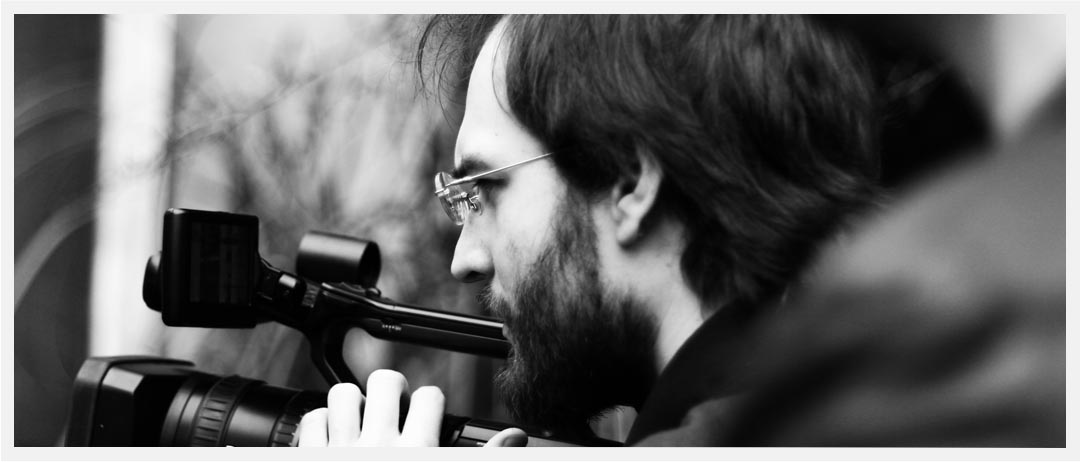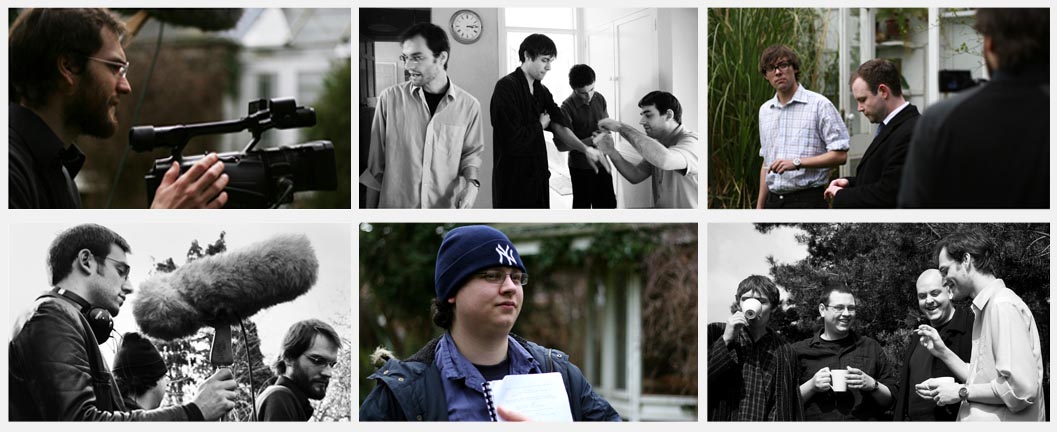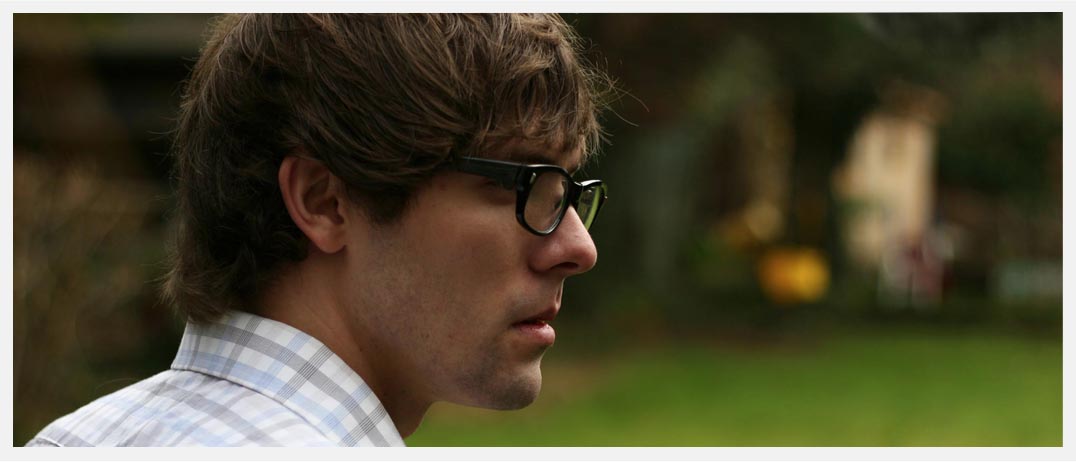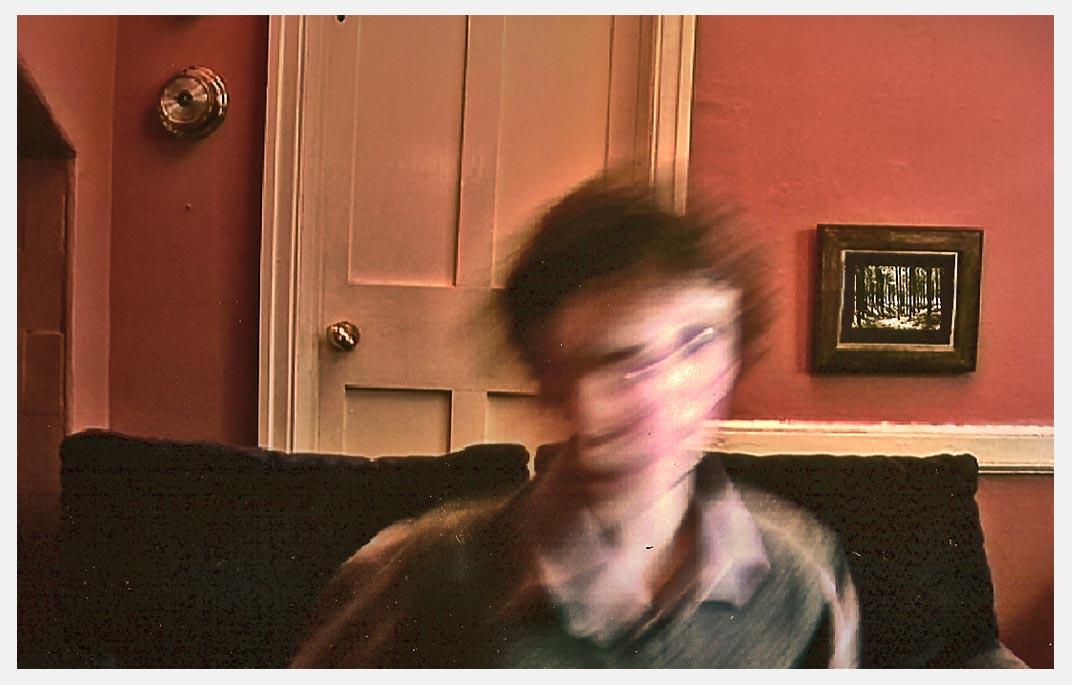Warning: Production Notes contain spoilers for the film ‘Holmewood’.
PRE-PRODUCTION
Following the success of their first short film When I Get Low, (completed in winter 2005), members of Bossfilm determined to set their sights on a longer form and a more involved project. By consensus, the team agreed on the horror genre and using the woods as a location for filming.
Writers David Hering and Richard Hughes drew inspiration from the M.R. James-style of ghost story, televised by the BBC in their A Ghost Story for Christmas strand, which first aired in the 1970’s and has since had sporadic revivals:
“We have always been fascinated by the idea that ghosts are projections of an individual’s psychology, rather than straightforward ‘scary monsters’, and have drawn inspiration from films and television that explore this area of the supernatural. Films like The Stone Tape, The Woman In Black, Whistle And I’ll Come To You and Ghostwatch were very influential in both their intelligent exploration of the spirit world and, essentially, their sense of fear and dread…” – David Hering (Writer)
Collectively, the team wanted to use the filmmaking process as a conduit through which to explore not only the more extreme and disturbing edges of human experience, but also do something through which to explore the medium itself. Above all, the film needed to succeed as a ghost story, to engage and intrigue the audience and, of course, frighten the life out of them!
“The writing process was a delicate balance of showing and telling, of boiling the dialogue down to just the right words, or more often no words at all and rather actions. We wanted to give the audience just enough information for them to begin to unravel the various plot strands and also to hint at the deeper meanings and ideas behind the narrative, but we didn’t want to give them so much that they felt there was no room for them, that they could not bring their own interpretation to the film.” – Richard Hughes (Producer, Writer)
The script was designed specifically around the primary location of the house, which in real life is owned by Val and Doug Robinson. The house not only has a labyrinthine layout, with many dark and spooky corners, but is also filled with artwork created by the owners, artwork which would feature prominently in the film:
“We wrote specifically for our location, a house owned by a friend’s grandparents. The house, designed in different stages over many years, has a variety of different architectural styles and this seemed ideally suited to the uncertain psychological landscape within which our protagonist finds himself.” – David Hering (Writer)
PRODUCTION
“When discussing with Jonathan Hall his ideas for the visual style of the film prior to shooting, it was apparent that he had a very clear idea of not only how best to tell the story, but also how to build on the conceptual ideas behind the script using elegant visual motifs. Jon maintained his clear vision throughout the shoot which, with re-shoots, extended to just over twelve months. As well as establishing the tone of the film, Jon also designed the crucial set-piece sequences. Marshaling these sequences required focus and technical skill, not to mention stamina, to make them work as sequences, to be frightening, but also to make them sit seamlessly within the visual style and language of the piece.” Richard Hughes (Producer, Writer)
Production began on 6th April, 2006. The bulk of the film was shot in the house in eight successive weekends. The crew would shoot on location in the woods at Formby, the Ullet Road Unitarian and Holy Trinity Churches in Liverpool, and Moel Famau in North Wales.
“Our shooting crew was small: Jonathan Hall, Joe Johnson, Dave Hering and myself were joined by Sam Jones (who as well as assisting on the shoot also took the role of The Boy). This meant that we all had to pitch in with lighting, sound recording, set dressing, continuity, costume, makeup, physical effects and switch roles as required at a moment’s notice. We worked long hours, giving up all our free time in the evenings and over weekends to fit around full time, rent paying, day jobs.” – Richard Hughes (Producer, Writer)
“As we’d worked together before on When I Get Low, we had all developed a short-hand and a camaraderie which meant we could get through the long days. We were having so much fun making this, that if anyone were to witness us at work, they would be convinced we were making a comedy!” – Jonathan Hall (Director, Cinematographer)
In keeping with the evolving mystery in the story, writers Richard Hughes and David Hering’s screenplay allowed a lot of room for interpretation on the audiences’ part. The actors were directed to pitch their performances to encourage conjecture whilst keeping the rigid focus, intensity and tone the material demanded.
“We had the advantage of the relationship which Jon had built with Joe Johnson on When I get Low, meaning that the two could work intuitively together. Joe’s performance is beautifully expressive, one of varied subtle shades, steadily building in intensity, all the more remarkable given how spread out the shoot was. He is on screen for almost the entire film, and is given very few words to work with, he remains magnetic and manages to elicit sympathy even as his character becomes more distanced and difficult.” Richard Hughes (Producer, Writer)
“Joe Johnson’s restrained performance develops subtly, carefully revealing the fractured psychology of the main character throughout.” Jonathan Hall (Director, Cinematographer)
Joe Johnson – Actor “John Clayson” (Photo: Courtesy of Sarah Brown)
Val and Doug Robinson’s generosity, in opening their house to the filmmakers of a weekend, and providing sumptuous feasts to keep them going can not be thanked enough. This film would absolutely not have been possible without their kind assistance.
Actress Molly Taylor generously gave her time to voice the role of John Clayson’s Girlfriend, a small but significant role which adds further dimension to John’s character, and provides one of the film’s few moments of light relief.
Fairly late into the filming schedule, scenes involving the Groundsman were written. Les James, who appears in Alsop Theatre productions, was cast as The Groundsman in his first film role. Through rehearsals, filming in the graveyard and long hours of ADR, his energy and enthusiasm were boundless. He has been a keen advocate in the promotion of the film and he remains a valued Bossfilm member.
POST-PRODUCTION
Editing was done during the week whilst Principal Photography continued on weekends. This gave the filmmakers a good indication of what was working and what wasn’t.
“In addition to playing the role of David McLeod in the film, Dan O’Toole was also our primary editor. Working closely with Jon, Dan helped to establish the slow building rhythms and counter-rhythms of the film, to draw out the tension and to deliver the punch of the set pieces.” – Richard Hughes (Producer, Writer)
At the end of the first year, the first assembly cut was completed, but the first ten minutes, shot quickly in the first full weekend of principal photography, was found to be tonally different to the rest of the film. Both Dan and Joe leapt at the opportunity to revisit the opening scenes and aside from a few extra pick-up shots, this happy experience concluded filming on ‘Holmewood‘.
“Dan also worked on the special digital effects which were necessary for some of the sequences to augment the on-set physical effects. He was joined in this task by David Franklin who also produced the final digital grading of the film. These digital effects are absolutely seamlessly integrated into the fabric of the film. The decision was made very early on that we would use primarily photographic, photo-chemical style optical effects on the film, to remain consistent with our key themes and to give the film a timeless, classic feel, and the digital effects have been achieved entirely in this spirit.” – Richard Hughes (Producer, Writer)
Composer Louis Johnson was involved with the project from the very outset. Remarkably, he only saw the first assembly cut once before the premiere of his ‘Homewood Study’ concert piece, the recording of which would become the soundtrack to the film.
“There were two main motivating factors behind the composition of ’Holmewood Study’: my desire to write a piece for cello and a request from some friends of mine to provide music for a film project. As I planned to use a combination of cello and piano for the filmmusic, it was suggested to me that I might combine the two projects, that is, compose a piece for cello and piano that, although existing as a work in its own right, would also form the basis for the film score.” Louis Johnson (Composer)
“Composer Louis Johnson was involved with the project from the very first discussions. I feel it is of vital importance that a film is designed with the music in mind from the outset. We had the added advantage of working with Louis on When I get Low and also of being familiar with his non-film work, meaning we had a very clear idea of the type of tone his music could deliver, and he had a very clear idea of what we were aiming for visually. Louis actually wrote the basis for the score as a standalone concert piece based solely on the script and it was at this concert stage that we were extremely fortunate to procure the services of world class musicians Jonathan Aasgaard and Ian Buckle from the Royal Liverpool Philharmonic Orchestra. Louis score is incredibly effective in conveying the emotional and psychological turmoil of our main character and it is a work of originality and integrity.” Richard Hughes (Producer, Writer)
You can watch the premiere performance of Louis Johnson’s ‘Holmewood Study’ here:
“I decided the structure of the concert piece would be broadly analogous to that of the film. In the work, quiet, spare, ‘isolated’ musical material is disrupted by more aggressive, ‘haunting’ episodes and by a ‘dreamlike’ refrain. These aspects remain fairly discreet from one another until the peroration, in which they are merged to create an intense, climactic coda.” Louis Johnson (Composer)
During the early stages of development, it became apparent that there would need to be something quite elaborate in terms of sound design. Sound is a vital component in any film, but especially in the horror genre. In addition to the special sound elements, due to the complications of working on locations over which the filmmakers did not have complete control, almost all of the dialogue, sound effects and foley had to be re-created from scratch.
Tom Smith and Peter Fletcher would heroically take on the challenge. This long and involved process once again saw the whole creative team pitch in to deliver the final sound-scape. The team cannot thank Tom and Fletch enough for their outstanding work and dedication to the cause, without which, the film could not have been completed.
PREMIERE AND RELEASE
‘Holmewood’ was first shown publicly on September 4th, 2010 at the Portobello Film Festival. Although the team had a great time at the event, it was decided that a bespoke premiere closer to home, for friends, family and those interested in ghost stories would serve as a more rewarding celebration of the film’s completion. Thanks to Les James and Alsop Theatre the premiere was held December 2nd, 2010 at The Plaza cinema in Crosby to a packed house.
“The fact that the entire process took around four years provided us with an understanding of the stamina required to undertake a substantial film project, and we were incredibly lucky to be working with people whose work ethic, visual style and unflagging devotion to the project allowed us to complete a film with which we were all happy, and one that we feel retained the spirit of our original idea.” – David Hering (Writer)
“I am confident that we have far and away exceeded our ambitious goals. Complex notions of identity and memory, the making and the meaning of images, the metaphysical and the metafictional, are explored with subtlety within a tense and gripping mystery, containing some genuinely terrifying set pieces. The film has been finished to professional standards and I feel that technically and artistically the film can indeed stand alongside professionally made films. I think that we have made a very effective horror film, but one that also has a great deal of artistic integrity. Whatever the film’s fate, I am and will remain immensely proud of what we achieved. That we achieved all of this totally independently, without financial backing of any kind, is remarkable, though hopefully irrelevant to the final quality of the film. That is to say: I don’t think that the film is good ‘considering the circumstances in which it was made’, I simply think the film is good.” – Richard Hughes (Producer, Writer)
“Little did we realise it would take four years for our dedicated team to make this film. Having released it on the big screen (and now online) I am delighted that ‘Holmewood’ can at last enjoy an afterlife – much like our ghosts let loose in their own picture house…” Jonathan Hall (Director, Cinematographer)
All quotes taken from original ‘Holmewood‘ Festival Press Kit (Copyright © 2010 Bossfilm)
(All website content Copyright © 2015 Bossfilm/Jonathan Hall, except Sarah Brown photographs Copyright © 2006 Sarah Brown)










